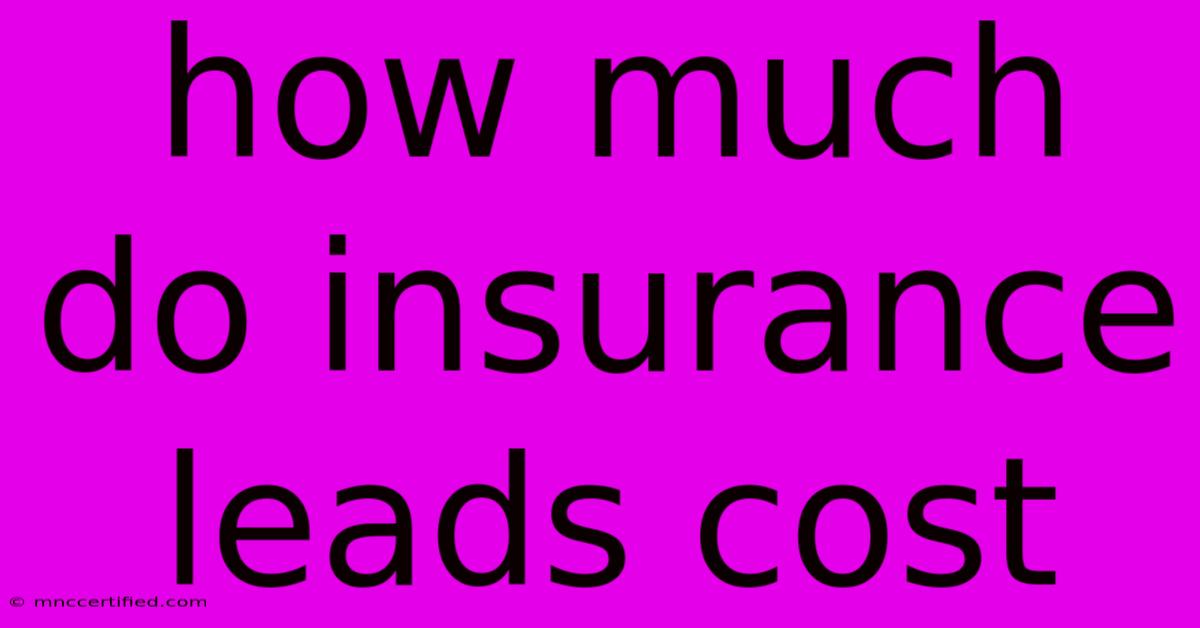How Much Do Insurance Leads Cost

Table of Contents
How Much Do Insurance Leads Cost? A Comprehensive Guide
The cost of insurance leads can vary wildly, making it crucial to understand the factors influencing price and how to find the best value for your business. This comprehensive guide will delve into the pricing structures, influencing factors, and strategies for acquiring high-quality leads at competitive rates.
Understanding Insurance Lead Pricing Models
Insurance lead pricing isn't a one-size-fits-all proposition. Several models exist, each with its own advantages and disadvantages:
1. Cost Per Lead (CPL):
This is the most common model. You pay a fixed price for each lead generated, regardless of its quality or conversion rate. CPL pricing offers transparency but can be unpredictable regarding ROI if lead quality is inconsistent. Expect to pay anywhere from $5 to $50+ per lead, depending on factors discussed below.
2. Cost Per Acquisition (CPA):
With CPA pricing, you only pay when a lead converts into a sale or policy. This model aligns incentives with the lead provider, encouraging them to deliver higher-quality leads. However, it can be riskier upfront, as you won't see immediate results. CPA costs can range significantly, often exceeding CPL costs due to the higher conversion requirement.
3. Flat Fee/Monthly Retainer:
Some providers offer a flat fee or monthly retainer for a set number of leads. This provides predictability in budgeting but may not offer the flexibility to scale your lead generation efforts as needed. The cost varies greatly depending on the volume and quality of leads promised.
Factors Affecting Insurance Lead Costs
Numerous factors impact the price you'll pay for insurance leads:
1. Insurance Type:
Leads for high-value insurance products like life insurance or commercial insurance typically cost more than those for simpler products like auto or renters insurance. This reflects the higher potential commission and greater effort involved in securing these policies.
2. Lead Quality:
High-quality leads, those exhibiting strong purchase intent and providing accurate information, command a higher price. Conversely, low-quality leads with inaccurate or incomplete data are cheaper but less likely to convert. Prioritize quality over quantity for better ROI.
3. Lead Source:
Different lead generation sources have varying costs. Organic leads (from your website or SEO efforts) are cost-effective but require sustained effort. Paid advertising (PPC, social media) provides faster results but can be expensive. Lead aggregators offer a diverse range but often come with higher costs.
4. Geographic Location:
Leads in highly competitive or densely populated areas tend to be more expensive due to increased demand. Conversely, leads from less populated areas might be cheaper but may also offer fewer conversion opportunities.
5. Lead Generation Method:
The methods used to generate leads also influence cost. Direct mail is generally less expensive than digital marketing, but digital methods often offer better targeting and tracking.
Strategies for Optimizing Insurance Lead Costs
To get the most value from your insurance lead budget:
- Thoroughly vet lead providers: Check their reputation, lead quality, and client testimonials before committing.
- Focus on lead qualification: Implement robust processes to qualify leads and prioritize those most likely to convert.
- Analyze your ROI: Track your lead generation costs and conversion rates meticulously to optimize your spending.
- Diversify your lead sources: Don't rely on a single source. Explore various channels to reduce dependence and maximize reach.
- Invest in lead nurturing: Nurture leads through email marketing and other communication channels to increase conversion rates.
Conclusion: Finding the Right Balance
The cost of insurance leads is a crucial consideration for any insurance agency. By understanding the different pricing models, influencing factors, and strategies for optimization, you can effectively manage your lead generation budget and achieve a strong return on investment. Remember that high-quality leads are ultimately more valuable than a large quantity of low-quality leads, regardless of cost. Focus on building a strategy that delivers consistent, qualified leads and aligns with your overall business goals.

Thank you for visiting our website wich cover about How Much Do Insurance Leads Cost. We hope the information provided has been useful to you. Feel free to contact us if you have any questions or need further assistance. See you next time and dont miss to bookmark.
Featured Posts
-
Leugers Insurance Maria Stein Ohio
Nov 23, 2024
-
Alliance Insurance Statesville Nc
Nov 23, 2024
-
Sporting Cp Vs Amarante Match Preview
Nov 23, 2024
-
Bonding Activities For Siblings
Nov 23, 2024
-
Sporting Amarante Preview New Leaders Debut
Nov 23, 2024